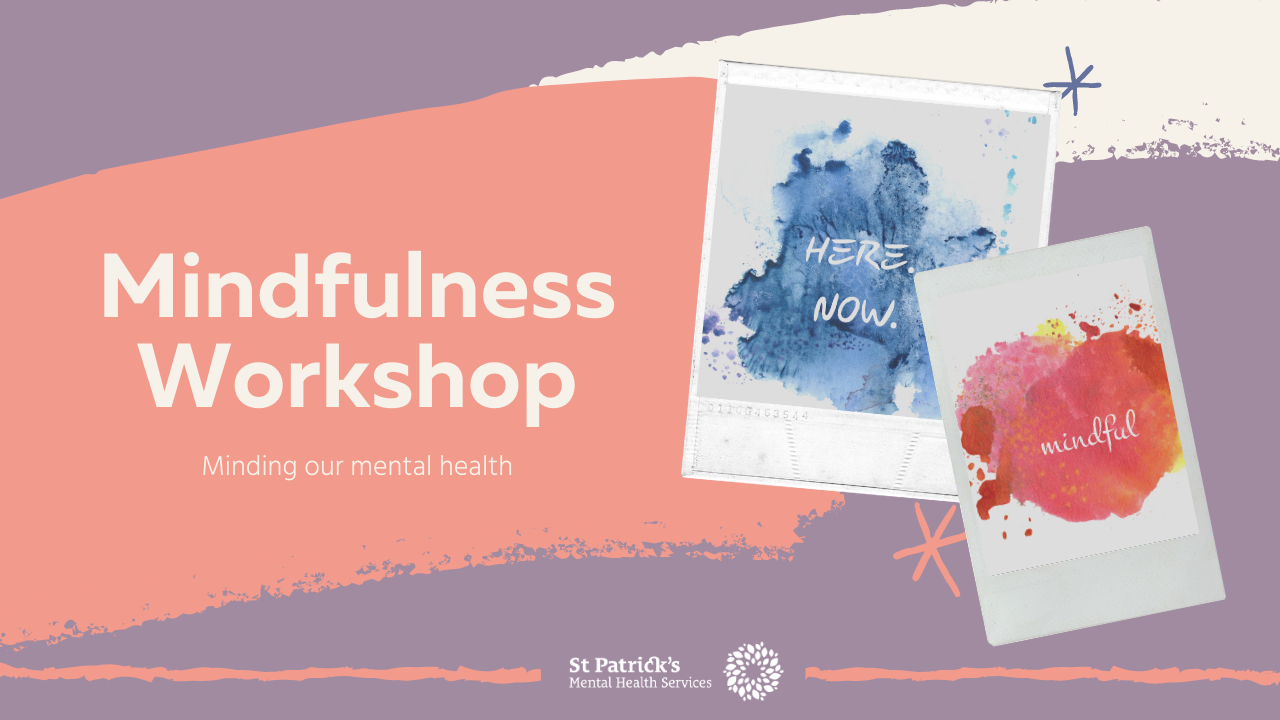
Take some time for yourself with a guided mindfulness relaxation practice.
Mindfulness is a practice which enables us to focus on the present moment, to take notice of our thoughts, feelings and what is going on around us without judgement, and to calm our minds.
Watch the mindfulness workshop below to learn more about mindfulness and take part in a mindfulness practice with Debbie van Tonder, Programme Manager of our Dean Clinics here in St Patrick’s Mental Health Services (SPMHS).
Debbie is a cognitive behavioural psychotherapist and a mindfulness practitioner. She focuses the workshop on using mindfulness to reduce stress, looking at what mindfulness is, why we do it, and how it's linked to mental health and stress management. She gives some simple mindfulness practices that you can do as part of your normal, everyday routine without needing anything special or specific to practice with.
While Debbie gives this mindfulness workshop outdoors, she notes that mindfulness doesn't have to practiced in a specific setting; it can really be done wherever you are – whether that’s at home, at work, in the garden or a park.
In the video, the arrival practice begins at 2.20; the mindfulness theory at 6.30, and the mindfulness practices at 14.45. You can also read more below.
What is mindfulness?
Mindfulness is a type of meditation. It’s about paying attention to the present moment, but in a particular way; that means we pay attention to the moment, but we don’t place a judgement on it. Whether it’s a happy or unhappy moment, it doesn’t matter; what matters is that we don’t judge it. We aren’t critical of the moment or don’t think it should be different; whatever is there for you at that moment in time is there with no sense of judgement.
Why is mindfulness important?
We can get caught up in what are called “mindless traps” or negative mindsets that can be automatic. We all have these at times, and we all have patterns around them; some people may catastrophise (or imagine the worst-case scenario) a lot, others may be more self-critical, and some may ruminate a lot or be more obsessive. By practicing mindfulness, becoming aware of the moment and not judging it, we step out of the mindless traps; we step into the moment and out of the thinking mind.
Mindfulness can also help us to update our thinking minds. One mindless trap can be to get caught up in situations or experiences from the past. Mindfulness allows to experience the present moment as if it’s a new moment. It doesn’t matter if it feels the same as a previous moment; it feels the same because our thoughts are the same, but, by experiencing it as a new moment, we can allow ourselves to respond differently in that new moment in time. If we can interrupt our thinking patterns, we have a different experience.
Practicing mindfulness doesn’t mean we won’t ever get stressed, we won’t ever feel cross or unhappy; all it means is that we will pause, we will reflect, and we have a choice then in how we respond to the moment in time.
What are the elements of mindfulness?
The elements of mindfulness include:
- Awareness: being aware of the moment and what’s happening in it
- Non-judgement: not judging what’s happening in the moment
- Non-reactivity: not reacting to the moment.
When we become aware of the moment, we do not judge it and we do not react to it: we pause, reflect and refocus our awareness. Refocusing awareness is really important in mindfulness: by doing this, we interrupt our negative thinking styles and develop what is known as “detached acceptance”. Detached acceptance is the end goal in mindfulness. This is about not attaching ourselves to negative thoughts and allowing them to take us on a run; we just accept what’s there. It doesn’t mean we have a fatalistic or hopeless attitude; it means we have a choice to look at the thoughts from a different perspective and make changes.
How do you practice mindfulness?
Arrival practice
Debbie starts the mindfulness workshop with an arrival practice, using a singing bowl to help us arrive in the moment and to step back from the busyness of the day. It focuses our attention and awareness, and helps indicate the beginning of a mindfulness practice.
The arrival practices signals an invitation to become aware of your body. Are you sitting, standing or lying down? What is your body’s position? Make sure your back is straight and upright, so that you’re not too tense, but your spine is straight and your chest is open to allow you to breathe without obstruction. Perhaps close your eyes; feel your feet on the floor or in your shoes. Leave the busyness of the day behind you, and arrive in this moment.
Take a deep breath to help ground yourself, becoming aware of the silence or noise around you, and tuning into yourself and where you are right now.
Become aware of your thoughts and what’s happening for you at this moment in time. Maybe your thoughts are very busy or maybe you’re feeling a little silly or uncomfortable doing this practice. If you’re struggling to be in the practice, don’t judge yourself; just be aware that that’s what’s coming up for you.
Mindfulness of the breath and senses
There are lots of different ways to practice mindfulness. Debbie takes us through two types of practice - mindfulness of the senses and mindfulness of the breath. Mindfulness of the senses is about tuning into what you see, hear, taste and touch. Mindfulness of the breath is about being aware of the breath, without controlling or changing the breath; this can ground us, allow us to pause, and help us to move onto a next step.
What if mindfulness doesn't work?
Debbie explains that she often talks to people who say they’ve tried mindfulness and it doesn’t work for them. She explains that she suggests to them that they mightn’t have found a form of mindfulness that works for them – maybe the practices they tried didn’t work at the time because they were too long, too intense, or similar. Debbie suggests that, in a way, we almost have to become “mindful-fit”; in the same way we would train for sports or athletics, we have to train ourselves in or develop a level of fitness for mindfulness.
If you’ve tried mindfulness before and it didn’t work, Debbie suggests starting small: slowing down, taking a walk, becoming aware of your movements, tuning into your body, and noticing the environment around you. One moment of awareness will lead to another moment and then another, until you are comfortable in a mindfulness practice. If you find it hard to sit with your breath for five minutes, start by sitting with your breath for half a minute, then one minute, then two minutes and so on. Before you know it, you’ll be able to sit with your breath for a longer time.


